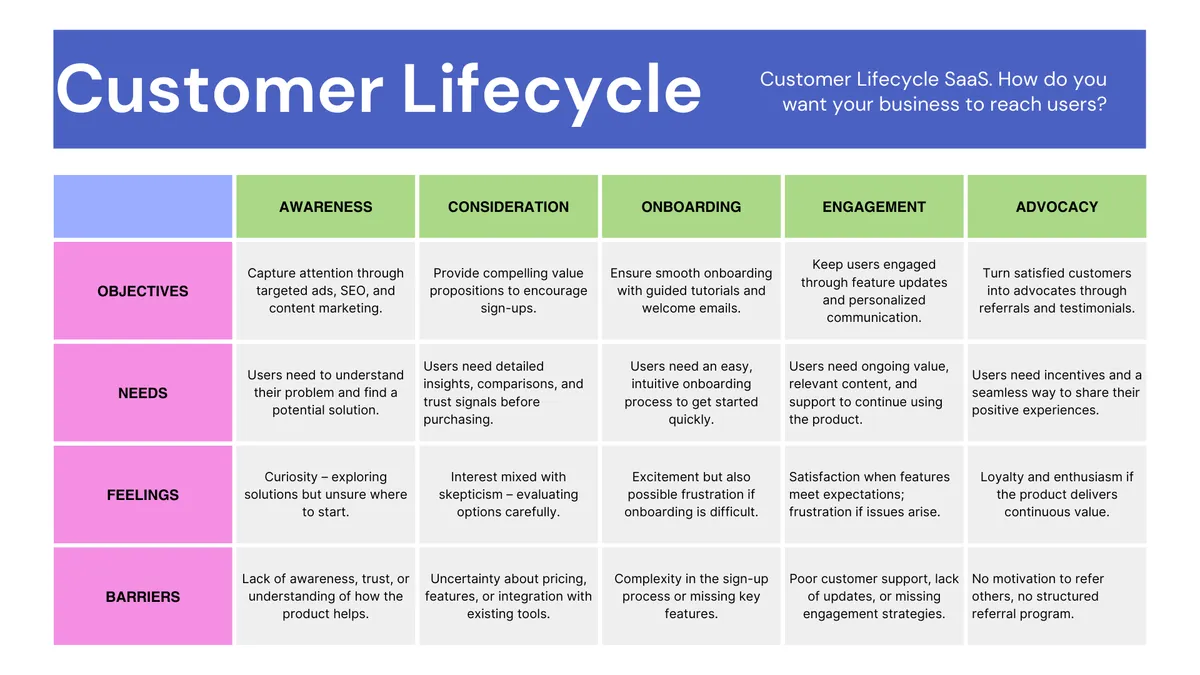
Why Customer Journeys Matter in SaaS
In the competitive world of CRM for SaaS, understanding the customer journey is crucial for success. A well-structured customer journey not only enhances user experience but also significantly impacts key metrics such as Customer Acquisition Cost, Churn Rate, and Customer Lifetime Value. By mapping out the customer journey, SaaS companies can better understand user behavior, leading to improved retention and conversion rates.
Here’s why customer journeys are essential in the SaaS industry:
-
Understanding User Behavior: By analyzing each stage of the customer journey, businesses can gain insights into how users interact with their product, allowing for more informed decision-making.
-
Improving Retention and Conversion: A seamless journey ensures that users find value quickly, reducing churn and increasing the likelihood of conversion from trial to paid users.
-
Guiding Customers with CRM: A robust CRM system plays a pivotal role in guiding customers through their journey, offering personalized experiences and timely interventions.
By focusing on these aspects, SaaS companies can create a customer journey that not only attracts new users but also turns them into long-term advocates, ultimately driving growth and profitability.
Understanding the SaaS Customer Lifecycle

In the realm of CRM for SaaS, understanding the customer lifecycle is pivotal for optimizing Customer Acquisition Cost, reducing Churn Rate, and enhancing Customer Lifetime Value. The SaaS customer lifecycle is a journey that encompasses several key stages, each requiring strategic attention to ensure a seamless transition from one phase to the next.
1. Awareness: First Interactions with Your Brand
The journey begins with awareness, where potential customers first encounter your brand. This stage is crucial for capturing interest and setting the stage for further engagement. Effective marketing strategies and a strong online presence are essential to make a lasting impression.
2. Consideration: Evaluating Your Product Against Competitors
During the consideration phase, prospects evaluate your product alongside competitors. Providing clear, compelling value propositions and leveraging customer testimonials can help sway decisions in your favor. A robust CRM system can track these interactions, offering insights into user preferences and pain points.
3. Onboarding: The Critical Moment of User Adoption
Onboarding is a critical phase where users begin to interact with your product. A smooth onboarding process ensures users quickly find value, reducing the risk of churn. Personalized onboarding experiences, guided tutorials, and responsive support are key to successful user adoption.
4. Engagement & Retention: Keeping Users Active and Engaged
Once users are onboarded, the focus shifts to engagement and retention. Regular updates, personalized content, and proactive customer support help maintain user interest and satisfaction. Monitoring engagement metrics through CRM tools can provide valuable insights into user behavior and preferences.
5. Expansion & Advocacy: Turning Customers into Long-Term Advocates
The final stage involves turning satisfied customers into advocates. Encouraging feedback, offering loyalty programs, and creating opportunities for upselling can enhance Customer Lifetime Value. Happy customers are more likely to recommend your product, driving organic growth.
By understanding and optimizing each stage of the SaaS customer lifecycle, businesses can create a more effective and efficient customer journey, ultimately leading to increased retention and growth.
Key CRM Strategies to Optimize Each Stage
In the competitive world of CRM for SaaS, optimizing each stage of the customer journey is crucial for reducing Customer Acquisition Cost, minimizing Churn Rate, and maximizing Customer Lifetime Value. Here are some key strategies to enhance each phase of the SaaS customer lifecycle:
1. Automating Lead Nurturing Through Personalized Emails
Personalized email campaigns are a powerful tool for nurturing leads. By leveraging CRM data, you can tailor messages to address specific user needs and pain points, increasing the likelihood of conversion. Automation ensures timely follow-ups, keeping your brand top-of-mind.
2. Real-Time Event Tracking for Timely Engagement
Real-time event tracking allows you to monitor user interactions as they happen. This data is invaluable for identifying engagement opportunities and responding promptly to user actions, such as trial sign-ups or feature usage, enhancing the overall customer experience.
3. Customizable Workflows to Trigger the Right Actions
Customizable workflows in your CRM system can automate processes and trigger specific actions based on user behavior. Whether it's sending a welcome email or offering a discount to inactive users, these workflows ensure that the right message reaches the right audience at the right time.
4. Segmenting Users Based on Behavior for Targeted Messaging
Segmenting your audience based on behavior allows for more targeted and effective communication. By categorizing users into groups such as new sign-ups, active users, or potential churners, you can craft messages that resonate with each segment, improving engagement and retention.
Implementing these CRM strategies not only streamlines your operations but also enhances the customer journey, leading to improved retention metrics and a stronger bottom line. By focusing on personalization and timely engagement, SaaS companies can foster long-term relationships with their customers, ultimately driving growth and success.
The Role of Event-Driven CRM in SaaS Growth

In the dynamic landscape of CRM for SaaS, leveraging event-driven CRM can be a game-changer for businesses aiming to enhance customer engagement and drive growth. By focusing on real-time data and automated responses, event-driven CRM systems can significantly improve Customer Acquisition Cost, reduce Churn Rate, and boost Customer Lifetime Value.
Understanding Event-Driven CRM
Event-driven CRM is a strategy that utilizes real-time data to trigger specific actions based on user interactions. This approach allows SaaS companies to respond promptly to customer behaviors, ensuring a more personalized and timely customer experience.
Benefits of Real-Time Data
-
Enhanced Customer Experience: By reacting to user actions as they occur, businesses can provide immediate support and relevant offers, improving overall satisfaction.
-
Increased Engagement: Timely interactions keep users engaged, reducing the likelihood of churn and increasing retention metrics.
-
Optimized Marketing Efforts: Real-time insights allow for more targeted marketing campaigns, ensuring that messages reach the right audience at the right time.
Examples of Automated Event-Based Triggers
Implementing automated triggers can streamline operations and enhance user engagement. Here are some examples:
-
Welcome Sequences: Automatically send a series of onboarding emails to new users, guiding them through the initial setup and highlighting key features.
-
Upsell Opportunities: Trigger personalized offers when users reach specific milestones or exhibit behaviors indicating readiness for an upgrade.
-
Re-engagement Campaigns: Automatically reach out to inactive users with special offers or reminders to encourage them to return.
By integrating event-driven CRM strategies, SaaS companies can create a more responsive and personalized customer journey. This not only enhances the user experience but also contributes to long-term growth and success by improving key metrics such as Customer Lifetime Value and retention rates.
Personalization and Data-Driven Decision Making

In the competitive world of CRM for SaaS, personalization and data-driven decision making are crucial for enhancing customer experiences and driving growth. By leveraging CRM analytics, businesses can gain valuable insights into user behavior, enabling them to tailor their strategies to meet individual customer needs.
Understanding User Needs with CRM Analytics
CRM systems collect vast amounts of data, which can be analyzed to understand user preferences and behaviors. This data helps in identifying patterns and trends, allowing businesses to make informed decisions that align with customer expectations.
-
Behavioral Insights: Analyze user interactions to understand what features are most popular and which areas need improvement.
-
Feedback Analysis: Use customer feedback to refine products and services, ensuring they meet user demands.
Leveraging AI and Machine Learning
Artificial Intelligence (AI) and machine learning are powerful tools in predicting customer behavior. By analyzing historical data, these technologies can forecast future actions, enabling proactive engagement strategies.
-
Predictive Analytics: Anticipate customer needs and offer solutions before they even realize they need them.
-
Automated Recommendations: Provide personalized product recommendations based on past behavior and preferences.
Personalizing Outreach Based on In-App Activity
Personalization goes beyond addressing customers by their first name. It involves tailoring communications based on specific user actions within the app.
-
Targeted Messaging: Send personalized messages triggered by specific in-app activities, such as completing a tutorial or reaching a milestone.
-
Dynamic Content: Use dynamic content in emails and notifications to reflect the user's current status or achievements within the app.
By integrating personalization and data-driven decision making into your CRM strategy, you can significantly improve Customer Acquisition Cost, reduce Churn Rate, and enhance Customer Lifetime Value. This approach not only fosters a deeper connection with your users but also drives long-term success for your SaaS business.
Measuring Success: KPIs for Customer Journey Optimization
In the realm of CRM for SaaS, understanding and optimizing the customer journey is crucial for driving growth and ensuring long-term success. Key Performance Indicators (KPIs) play a vital role in measuring the effectiveness of your strategies and identifying areas for improvement. Here, we delve into the essential KPIs that can help you optimize your customer journey.
1. Customer Acquisition Cost (CAC)
The Customer Acquisition Cost is a critical metric that measures the cost of acquiring a new customer. By analyzing CAC, businesses can assess the efficiency of their marketing and sales efforts. A lower CAC indicates a more cost-effective strategy, allowing for better allocation of resources.
2. Activation Rate & Time to First Value (TTFV)
Activation Rate measures the percentage of users who reach a key milestone that signifies the start of their journey with your product. Time to First Value (TTFV) is the time it takes for a user to experience the initial value of your product. Optimizing these metrics ensures a smooth onboarding process, increasing the likelihood of user retention.
3. Engagement Metrics
Engagement metrics, such as active users and session length, provide insights into how users interact with your product. High engagement levels often correlate with increased satisfaction and loyalty, making it essential to monitor these metrics closely.
4. Churn Rate & Retention Metrics
The Churn Rate indicates the percentage of customers who stop using your product over a specific period. Retention metrics, on the other hand, measure the ability to keep users engaged over time. Reducing churn and improving retention are key to sustaining growth and maximizing revenue.
5. Customer Lifetime Value (CLV)
Customer Lifetime Value represents the total revenue a business can expect from a single customer account. By increasing CLV, companies can enhance profitability and justify higher acquisition costs, ultimately leading to a more sustainable business model.
By focusing on these KPIs, SaaS companies can gain a comprehensive understanding of their customer journey, enabling them to make data-driven decisions that enhance user experience and drive growth. Regularly reviewing and optimizing these metrics will ensure your CRM strategy remains effective and aligned with business goals.
Common Mistakes and How to Avoid Them

In the competitive world of CRM for SaaS, avoiding common pitfalls can significantly enhance your customer journey and improve metrics like Customer Acquisition Cost and Customer Lifetime Value. Here are some frequent mistakes and strategies to avoid them:
-
Overcomplicating Automation Sequences: While automation is a powerful tool, overly complex sequences can confuse users and lead to disengagement. Keep your automation simple and focused on delivering value at each stage of the customer journey.
-
Failing to Personalize Communication: Generic messages can alienate users. Use CRM data to tailor communications based on user behavior and preferences, enhancing engagement and retention.
-
Ignoring Key User Engagement Signals: Failing to monitor and respond to user interactions can result in missed opportunities. Implement real-time event tracking to stay informed and act promptly on user signals.
-
Not Aligning Sales, Marketing, and Customer Success Teams: Disconnected teams can lead to inconsistent messaging and a fragmented customer experience. Ensure all departments are aligned and working towards common goals to optimize the customer journey.
By addressing these common mistakes, SaaS companies can create a more seamless and effective customer journey, ultimately reducing Churn Rate and boosting Retention Metrics.
Building a CRM-Powered SaaS Growth Strategy

In the dynamic world of CRM for SaaS, crafting a robust growth strategy is essential for maximizing Customer Lifetime Value and minimizing Customer Acquisition Cost. A well-structured CRM strategy not only enhances customer engagement but also drives sustainable growth. Here’s how you can build an effective CRM-powered growth strategy:
1. Understand Your Customer Journey
Begin by mapping out the entire customer lifecycle, from Awareness to Advocacy. Understanding each stage helps in tailoring your CRM efforts to meet specific customer needs, ultimately improving Retention Metrics and reducing Churn Rate.
2. Leverage Data-Driven Insights
Utilize CRM analytics to gain insights into user behavior and preferences. This data is invaluable for making informed decisions and personalizing customer interactions. By understanding what drives engagement, you can optimize your strategies to enhance user satisfaction and loyalty.
3. Implement Event-Driven CRM
Adopt an event-driven approach to CRM, where real-time data triggers automated actions. This ensures timely and relevant communication, such as sending a welcome email sequence or upsell opportunities, which can significantly boost conversion rates.
4. Personalize Customer Interactions
Personalization is key to a successful CRM strategy. Use AI and machine learning to predict customer behavior and tailor your outreach based on in-app activity. Personalized experiences foster deeper connections and encourage long-term customer relationships.
5. Measure and Optimize
Regularly track key performance indicators (KPIs) such as Activation Rate, Time to First Value (TTFV), and Engagement Metrics. Analyzing these metrics helps in identifying areas for improvement and ensuring your CRM strategy aligns with business goals.
By integrating these elements into your CRM strategy, SaaS companies can create a seamless and effective customer journey that not only attracts new users but also retains and converts them into loyal advocates.